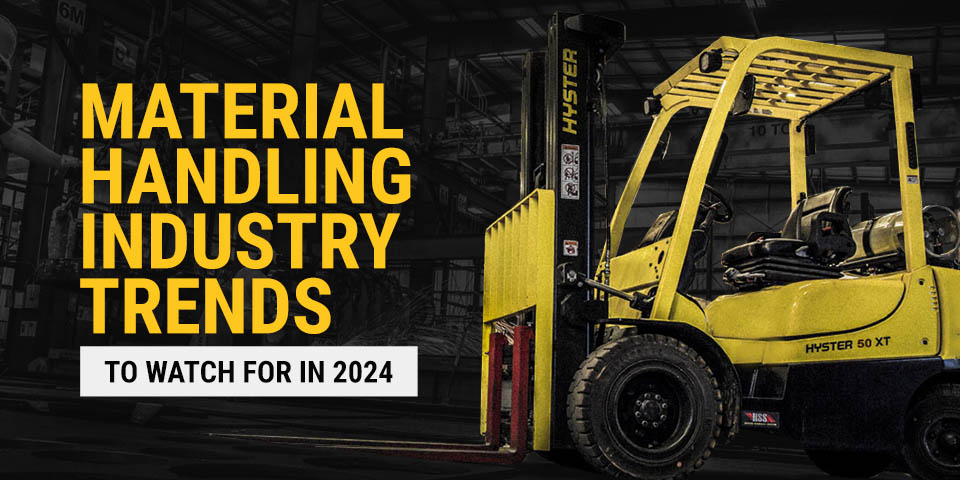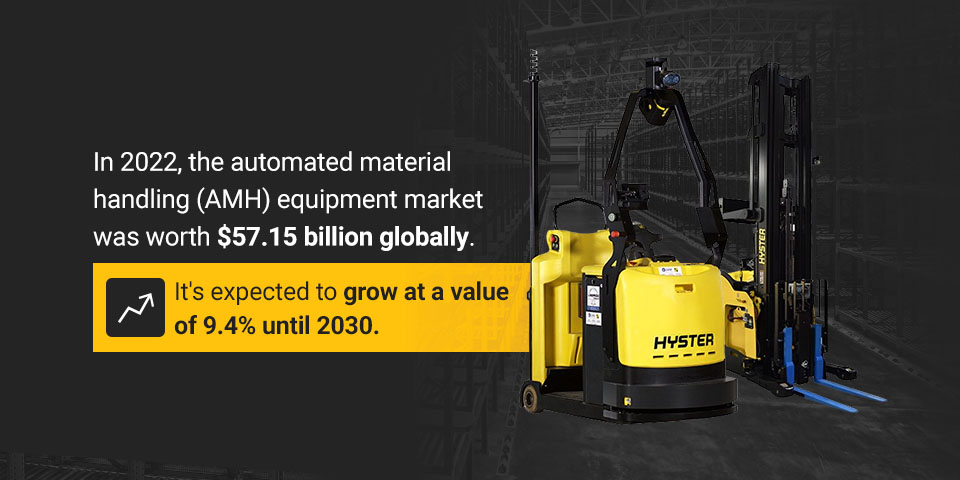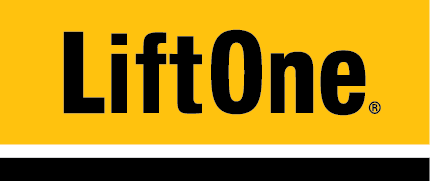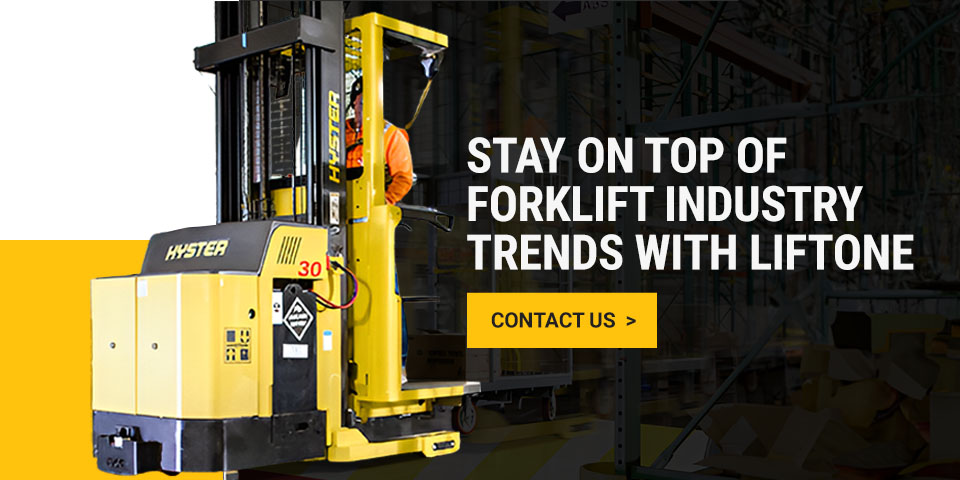Material Handling Industry Trends to Watch for in 2024

As we hit the ground running in 2024, it's important to keep our eyes peeled for new trends in the material handling industry. From new technologies and robotics to more enhanced safety features, new developments are taking center stage in the material handling equipment realm. Below, we'll dive into five key forklift industry trends that are expected to thrive this year:
- Emerging technologies
- Electrification
- Robotic integration
- Increase in forklift rentals
- Training and safety requirements
After exploring these trends, you may gain more clarity into what specific solutions your operation’s needs.
1. Emerging Technologies
Between automation, battery advancements and telematics solutions, technology is making great strides in the material handling industry — and the warehouse sector as a whole. Companies are integrating these technologies to optimize safety, productivity and efficiency. Here are some emerging technologies to leverage in 2024:
- Telemetry: Telemetry involves remote data collection with wireless technology. A telemetry system can help you monitor and keep track of your fleet. It makes it easier to stay on top of preventive maintenance and identify issues and repair needs. You can also track activity and usage trends to identify pain points in your facility. In turn, you can encourage fewer accidents and misuse cases, cultivating a safer work environment.
- Power sources: With the rapid shift from internal combustion engines to electric forklifts, advancements in battery technology are growing more prevalent. They allow forklifts to charge faster and run for longer durations. Lithium-ion batteries and hydrogen fuel cells, in particular, are popular avenues. Both power sources are incredibly long-lasting. In fact, they may be able to outlive the units they power.
- Automation: Autonomous mobile robots (AMRs) and automated guided vehicles (AGVs) are expected to gain more traction in 2024. They can automate material handling processes with impressive efficiency and precision, thus decreasing dependency on manual labor.
2. Electrification
More companies are adopting electric forklifts to reduce their emissions, operating costs, maintenance requirements and carbon footprint. Electric forklifts run on batteries instead of fossil fuels. This makes them a more eco-conscious alternative for factories and warehouses.
Compared to their fuel-powered counterparts, electric forklifts generate less noise and require minimal maintenance. While they do require to be charged, new technology allows for quick opportunity charging, with certain options refueling in as little as three minutes.
The increasing push for sustainability and low-emissions equipment is driving up the global electric forklift sector. According to data from Grand View Research, this market is expected to grow at a value of 14.9% until 2030. Research also shows that 69% of all shipped forklifts are electric.
3. Robotic Integration
Many companies are incorporating automation into their operations. Automation makes it easier to stay on top of fulfilling orders and maintaining an efficient supply chain without investing in more labor.
According to data from ABI Research, autonomous forklifts have experienced the most rapid growth of all AMR categories. An autonomous forklift can accurately pick inventory, navigate spaces and avoid obstacles without a human operator. Distribution centers and warehouses see a greater need for solutions like robotic forklifts to keep up with higher shipping volumes and increased customer demands.

In 2022, the automated material handling (AMH) equipment market was worth $57.15 billion globally. It's expected to grow at a value of 9.4% until 2030. Additionally, robotics led this market in 2022 with a 24% revenue share. Machine learning (ML) and artificial intelligence (AI) capabilities are driving the robotics segment growth within the AMH market.
Businesses are seeking ways to automate industrial processes to lower labor costs and improve productivity. Autonomous forklifts are a significant step in this direction. There's a variety of automated material handling solutions on the market that LiftOne can provide, including:
- Robotic reach trucks
- Robotic pallet trucks
- Robotic tow tractors
- Counterbalanced stackers
More robotic solutions can be provided through our partners at BlueSkye Automation.
4. Increase in Forklift Rentals
According to data from GlobeNewswire, the global forklift rental market is projected to reach $8.17 billion by 2028 with a compound annual growth rate (CAGR) of 4.78%. Renting forklifts is becoming a more mainstream option for various reasons, such as:
Cost
Due to the high initial price tag of a new forklift, many businesses and contractors are pursuing rental options as a more affordable route. Renting makes equipment more attainable as you can use units on a temporary basis instead of spending a hefty sum upfront.
Storage expenses also factor into equipment ownership. Many businesses lack the space and budget to store a full fleet of forklifts. Forklift rental demand has also risen due to market variables like high maintenance costs, depreciation, taxes and insurance requirements for new equipment.
Small startups, contractors entering the market and businesses with capital limitations can easily access the equipment they need when they need it. They can also defend themselves against financial instability.
Seasonal Industry Trends
In today's dynamic business landscape, various industries often face fluctuating demands driven by seasonal peaks and troughs. Renting equipment for seasonal demand allows for optimizing resource utilization, minimizing overhead costs and maintaining agility in an ever-changing business environment.
Renting allows businesses to efficiently scale their operations, accommodating increased production during peak seasons without committing to long-term investments that may become underutilized during off-peak periods. Additionally, renting ensures access to the latest technology and models without the financial burden of purchasing new. While also providing the flexibility to quickly adapt to changing market conditions and adjust their fleet size accordingly.
5. Training and Safety Requirements
According to the Occupational Safety and Health Administration (OSHA), over 96,000 forklift incidents occur annually. To prevent accidents in the workplace, businesses are pursuing more rigorous safety, training and certification requirements for their forklift operators. Below are some forklift safety trends to note in 2024:
- Robust training and certification programs: Businesses are implementing more stringent training requirements to verify all of their operators are trained on proper equipment use. Comprehensive operator training ensures your organization meets OSHA reporting requirements and general staff safety standards. You can also customize these training programs to your company and equipment. In addition to new hire certification classes, current operators can receive annual refreshers on these safety concepts.
- Telematics: As mentioned earlier, a telemetry system is a great way to surveil your fleet, prevent forklift misuse and encourage safer operation.
- Automation: AMRs and robotic forklifts can promote safety in the workplace since they minimize reliance on human operators and manual labor.
- Safety accessories: Companies are opting for forklift safety add-ons to prevent operator accidents, equipment damage and costly downtime. Some of these safety features include blind spot cameras, alarms and warning systems, flashing lights, speed limiters, seatbelts and fall protection.
- Operator assist safety technology: This solution empowers operators to maintain control while remaining acutely aware of their surroundings, including factors such as travel speed, load stability and object detection, fostering a safer and more productive working environment.
Stay on Top of Forklift Industry Trends With LiftOne
LiftOne is your source for innovative material handling and warehouse solutions. Equipped with technology like telematics, automation and advanced power sources, our solutions keep up with the ever-evolving industry trends. We have new and used forklifts available, and we carry some of the industry's most respected names:
- Hyster
- Yale
- Combilift
- JLG
- Ottawa
Want to learn more about our available material handling equipment or need assistance in choosing the right solution? Contact us online or give us a call at 855.543.8663! Otherwise, you can browse our selection and request a quote for the equipment you're looking for.
Linked Sources:
- https://www.liftone.net/technology/telemetry/
- https://www.liftone.net/technology/motive-power/
- https://www.grandviewresearch.com/industry-analysis/electric-forklift-market-report
- https://www.liftone.net/blog/increase-forklift-productivity/
- https://www.abiresearch.com/blogs/2023/04/11/self-driving-forklifts-for-warehouses/
- https://www.grandviewresearch.com/industry-analysis/automated-material-handling-equipment-market-report
- https://www.liftone.net/technology/robotics/
- https://www.globenewswire.com/en/news-release/2023/07/14/2704891/28124/en/Global-Forklift-Rental-Market-Assessment-2023-2028-Insights-Projections-and-Opportunities-by-Load-End-use-and-Region.html
- https://www.liftone.net/rental/
- https://www.liftone.net/blog/material-handling-equipment-market/
- https://www.liftone.net/technology/safety-solutions/
- https://www.liftone.net/parts-and-maintenance/training/
- https://www.liftone.net/new-equipment/forklifts/
- https://www.liftone.net/used-equipment/
- https://www.liftone.net/contact/
Unlinked Sources:












